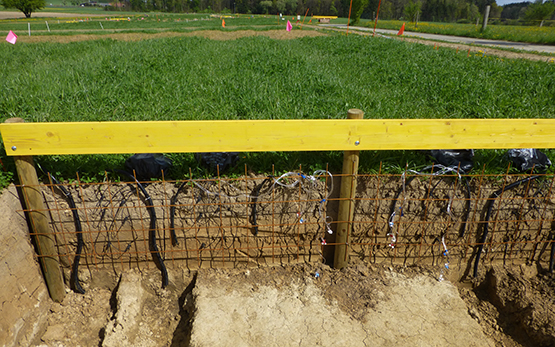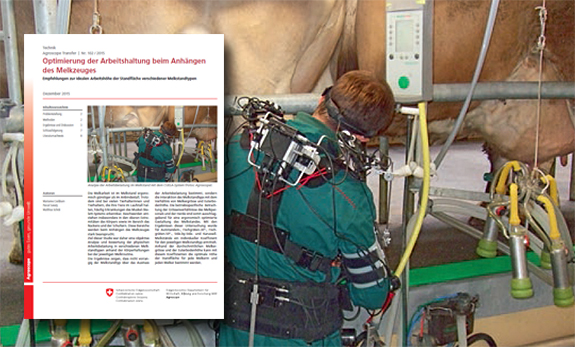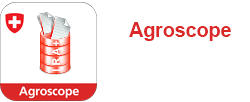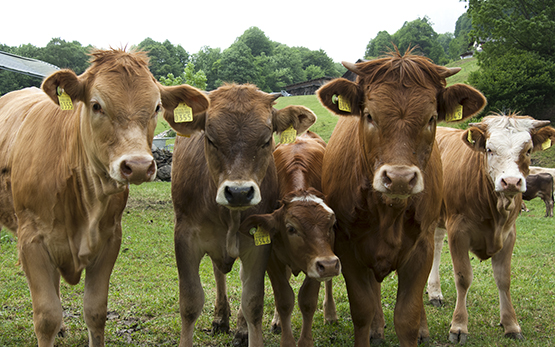Wang K., Räisänen S. E., Eggerschwiler L., He T., Islam M. Z., Li Y., Ma X., Siegenthaler R., Zeng Z., Dohme-Meier F., Niu M.
Feed intake regulation stabilized daily pattern of intake with little impact on rumen fermentation or methane mitigating efficacy of 3-nitrooxypropanol (3-NOP) in dairy cows.
In: ADSA Annual Meeting. 16-19 June, Hrsg. American Dairy Science Association, West Palm Beach, Florida (US). 2024, 78.
Pontiggia A., Eggerschwiler L., Reiche A.-M., Keil N., Dohme-Meier F.
Effect of shade availability on the physiological responses, water intake, and feeding behavior of grazing cows with an increasing heat load.
In: ADSA Annual Meeting. 16-19 June, Hrsg. American Dairy Science Association, West Palm Beach, Florida (US). 2024, 249-250.
Lerch S., Siegenthaler R., Numata J., Moenning J.-L., Dohme-Meier F., Zennegg M.
Accumulation rate, depuration kinetics, and tissue distribution of polychlorinated dibenzo-p-dioxins and dibenzofurans (PCDD/Fs) in suckler ewes (Ovis aries).
Journal of Agricultural and Food Chemistry, 72, (26), 2024, 14941-14955.
Rombach M., Schori F., Dohme-Meier F., Südekum K.-H., Münger A.
Impact of corn silage or corn silage plus protein supplementation on the ingestive and rumination behaviours, ruminal fermentation characteristics and efficiency of grazing dairy cows.
Journal of Animal Physiology and Animal Nutrition, 104, (8), 2024, 909-920.
Zähner M., Schrade S., Dohme-Meier F.
Untersuchte Varianten im Emissionsversuchsstall.
In: Ostschweizer AGFF Tagung 2024. 11. April, Hrsg. Ostschweizer AGFF, Wängi. 2024, 1.
Schrade S., Pitzen L., Dohme-Meier F., Zähner M.
Manure collecting robots: Investigations on cleaning quality and practical experiences on cattle farms.
In: AgEng Conference. 1-4 July, Hrsg. EurAgEng, Athen (GR). 2024, 354.
Schrade S., Zähner M., Steger D., Lazzari G., Zeyer K., Mohn J., Dohme-Meier F.
Measuring NMVOC and ammonia emissions from a naturally ventilated dairy housing: Comparison of different diets.
In: AgEng Conference. 1-4 July, Hrsg. EurAgEng, Athen (GR). 2024, 56.
Reiche A.-M., Martín-Hernández M. C., Spengler Neff A., Bapst B., Fleuti C., Dohme-Meier F., Hess H. D., Egger C., Portmann R.
The A1/A2 β-casein genotype of cows, but not their horn status, influences peptide generation during simulated digestion of milk.
Journal of Dairy Science, 107, (9), 2024, 6425-6436.
Mehaba N., Schrade S., Dohme-Meier F., Eggerschwiler L., Schlegel P.
Evaluation of different models predicting dry matter intake in multiparous lactating dairy cows.
In: Role of animal nutrition in sustainability goals for Switzerland and beyond. 23 May, Hrsg. ETH Zürich, Lindau. 2024, 42-43.
Eichinger J., Reiche A.-M., Fuchsmann P., Huber K., Dohme-Meier F.
Links between volatile organic compounds from exhaled breath and metabolites of blood and ruminal fluid of lactating dairy cows.
In: ADSA Annual Meeting. 16-19 June, Hrsg. American Dairy Science Association, West Palm Beach, Florida (US). 2024, 163.
Reiche A.-M., Tretola M., Pinotti L., Dohme-Meier F.
Backwaren-Ausschuss im Kraftfutter frischlaktierender Milchkühe – Auswirkungen auf Gesundheit, Leistung und Methanproduktion.
In: 24. Forum angewandte Forschung in der Rinder- und Schweinefütterung. 23. April, Fulda (DE). 2024, 45-48.
Reiche A.-M., Tretola M., Pinotti L., Dohme-Meier F.
Backwaren-Ausschuss im Kraftfutter frischlaktierender Milchkühe: Auswirkungen auf Gesundheit, Leistung und Methanproduktion.
In: 24. Forum angewandte Forschung in der Rinder- und Schweinefütterung. 23.-24. April, Fulda (DE). 2024, 45-48.
Xavier C., Morel I., Siegenthaler R., Dohme-Meier F., Dubois S., Luginbühl T., Le Cozler Y., Lerch S.
Three-dimensional imaging to estimate in vivo body and carcass chemical composition of growing beef-on-dairy crossbred bulls.
Animal, 18, (6), 2024, 1-13.
Eichinger J., Reiche A.-M., Dohme-Meier F., Fuchsmann P.
Comparison of solid-phase extraction cartridges to optimize the sampling of exhaled volatile organic compounds from dairy cows.
In: Spring conference Animal Nutrition. 23 May, Hrsg. Agridea / ETH Zurich, Lindau. 2024, 6-7.
Eichinger J., Reiche A.-M., Fuchsmann P., Huber K., Dohme-Meier F.
Investigating the suitability of exhaled volatile organic compounds to discriminate between cows in negative and positive energy balance.
In: Spring conference Animal Nutrition. 23 May, Hrsg. Agridea / ETH Zurich, Lindau. 2024, 8.
Wang K., Räisänen S.E., Eggerschwiler L., He T., Islam M.Z., Li Y., Ma X., Siegenthaler R., Zeng Z., Dohme-Meier F., Niu M.
Feed intake regulation stabilized daily intake pattern but reduced lactational performance with little impact on rumen fermentation or efficacy of 3-nitrooxypropanol (3-NOP) in dairy cows.
In: Role of animal nutrition in sustainability goals for Switzerland and beyond. 23 May, Hrsg. ETH Zürich. 2024, 42.
Gueddar R., Zähner M., Niu M., Dohme-Meier F., Schrade S.
Quantification of the dry herbage mass on pre- and post-grazing pastures with an electronic rising plate meter.
In: Spring conference Animal Nutrition. 23 May, Hrsg. Agridea / ETH Zurich, Lindau. 2024, 13.
Eichinger J., Reiche A.-M., Dohme-Meier F., Fuchsmann P.
Optimization of volatile organic compounds sampling from dairy cow exhaled breath using polymer-based solid-phase extraction cartridges for gas chromatographic analysis.
Journal of Breath Research, 18, (3), 2024, 1-18.
Reiche A.-M., Münger A., Dohme-Meier F.
Between- and within-animal variation of ruminal pH of dairy cows fed hay and herbage with increased nonstructural carbohydrate levels.
In: Proceedings of the 78th Conference of Nutrition Physiology. 5. March, Hrsg. Gesellschaft für Ernährungsphysiologie, Göttingen (DE). 2024.
Eichinger J., Reiche A.-M., Münger A., Fuchsmann P., Pimentel G., Huber K., Dohme-Meier F.
Investigation of the suitability of exhaled volatile organic compounds to discriminate different diets in lactating dairy cows.
In: GfE Tagung. 5-7 March, Hrsg. GfE, Göttingen. 2024.









